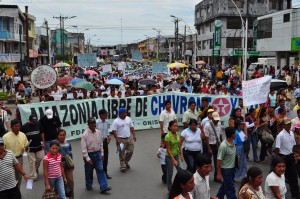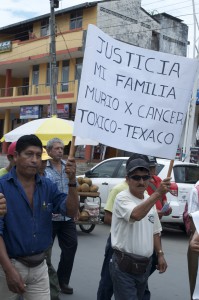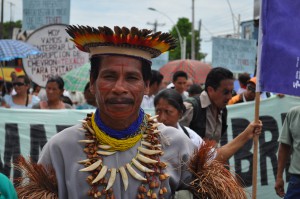 I’m sitting opposite the ‘Hotel Black Gold’ as the sun goes down over Lago Agrio and the streets start to hum with evening traffic, people returning home from work and families out walking together. It’s hard to believe that just a few short hours ago this street was filled with hundreds of indigenous people and peasant farmers loudly, passionately protesting Chevron’s (which became synonymous with Texaco when the two companies merged) continued refusal to clean up the toxic mess that they left behind almost twenty years ago. One man held a sign that said bluntly: “My family was killed by cancer, Texaco”.
I’m sitting opposite the ‘Hotel Black Gold’ as the sun goes down over Lago Agrio and the streets start to hum with evening traffic, people returning home from work and families out walking together. It’s hard to believe that just a few short hours ago this street was filled with hundreds of indigenous people and peasant farmers loudly, passionately protesting Chevron’s (which became synonymous with Texaco when the two companies merged) continued refusal to clean up the toxic mess that they left behind almost twenty years ago. One man held a sign that said bluntly: “My family was killed by cancer, Texaco”.

As Chevron works overtime to complicate, undermine and even corrupt the trial that is very likely to find them guilty of health and environmental damages to the tune of $27 billion, the resistance of the affected people grows stronger and more determined. The crowd marched from three directions and converged on the courthouse, where a member of one of the Indigenous group approached the doors to ask if he and four spiritual elders could enter to perform a cleansing ceremony.  The guard refused, saying (with a straight face and not a hint of irony) that it was impossible because the men would need to light tobacco and that might contaminate the inside of the courthouse. Undeterred, the elders from the Cofan, Siona and Secoya peoples performed their ceremony for the crowds on the street, grinding and drinking the bitter yoco root to give them all strength and renewed determination to fight Chevron.
The guard refused, saying (with a straight face and not a hint of irony) that it was impossible because the men would need to light tobacco and that might contaminate the inside of the courthouse. Undeterred, the elders from the Cofan, Siona and Secoya peoples performed their ceremony for the crowds on the street, grinding and drinking the bitter yoco root to give them all strength and renewed determination to fight Chevron.
Walking in the streets with these people was powerful and achingly painful at the same time – almost all of them are living without access to clean drinking water and many of them can’t afford to buy bottled water. I watched as an elderly indigenous woman drank deeply from a plastic water bottle that had been handed to her by one of the Frente (the coalition of groups working to fight Chevron and represent the affected peoples), wondering when the last time was that she had quenched her thirst without poisoning her body. It sounds dramatic, but it is no word of exaggeration to say that these people are dying. The indigenous groups are losing the last of their land and livelihoods and the peasant farmers are barely surviving on land that is growing more and more toxic as oil from the waste pits leaches out into streams and rivers.
Is there any doubt about this? I don’t think so. Just two nights earlier, I was sitting in the lounge of our hotel in Quito when a clean-cut American man came into the room and began to work on his computer. I asked him what his business in Ecuador was and he replied that he was just here for a visit to the Galapagos Islands. But as it turns out, Rick is a biophysical chemist, specializing in cancer research. So I inquired without telling him why I wanted to know: “is there any way that there is NO connection between long-term exposure to crude oil and cancer”. I expected to get some scientific prevarication, but Rick didn’t even pause, not for a second. “No way at all” he said.
Are you listening Chevron? These people need something very simple – clean water, free from crude oil residue. Or they will die.